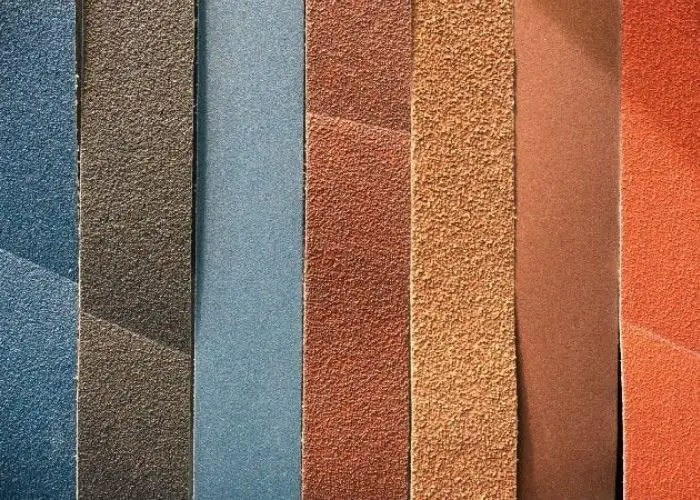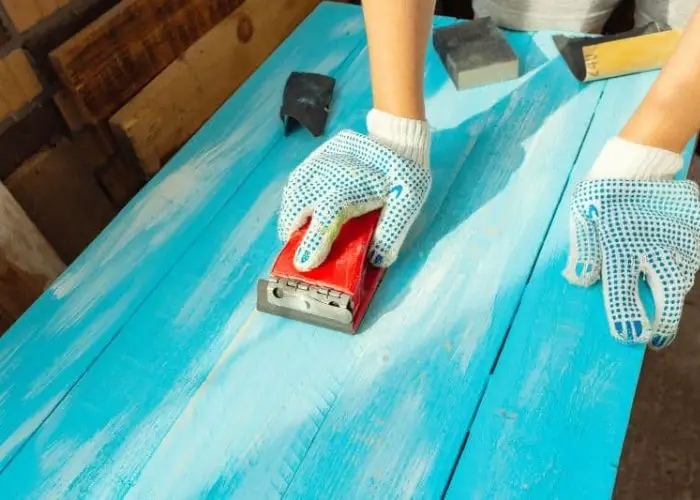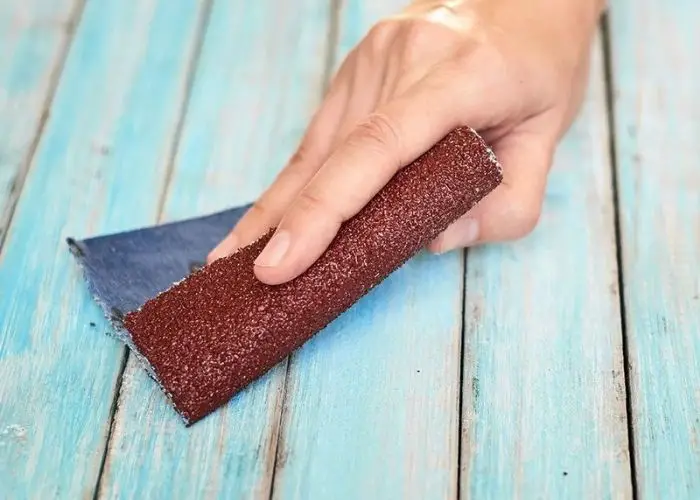Can you sand acrylic paint? This is a question that many people ask, and the answer can be a little confusing.
This comprehensive guide will explain everything about sanding acrylic paint.
We will discuss the different types of sandpaper that can be used and how to sand the paint properly.
We will also discuss the risks of sanding acrylic paint and how to avoid them.
So, can you sand acrylic paint? The answer is yes, but follow these guidelines to avoid potential problems!
Can You Sand Acrylic Paint?
Yes, you can sand acrylic paint. After it dries, use fine-grit sandpaper (400-600 grit). Start at the edge of the painted area, moving in circular motions. Sand evenly across the surface, maintaining consistent pressure. Sanding in one direction reduces unevenness. Wear a dust mask and ensure good ventilation.
What Type Of Sandpaper To Use For Sanding Acrylic Paint

There are a few different types of sandpaper that can be used to sand acrylic paint.
The most common type is aluminum oxide sandpaper, found at most hardware stores.
Another option is silicon carbide sandpaper, which is more expensive but will last longer. Either type of sandpaper will work fine for this project.
Can you wet sand acrylic paint?
Yes, you can wet sand acrylic paint. Wet sanding involves dampening the sandpaper with water, which reduces dust and creates a smoother finish.
After the acrylic paint dries, use a fine-grit sandpaper (400-600 grit). Dip the sandpaper in water, then gently sand the painted surface using circular motions.
This method helps in achieving a polished appearance. Ensure the surface is clean and dry before applying any further coatings.
How to Sand Acrylic Paint
Now that you know what type of sandpaper to use, it’s time to learn how to sand the paint properly.
Materials needed:
- Sandpaper
- Acrylic paint
- Water
- Damn cloth
- Sponge
Step 1: Wet the surface of the paint with a sponge.
Sanding can be a messy process, so it’s important to start by wetting the actual paint surface with a sponge. This will help to keep the paint dust down and make cleanup easier.
Step 2: Select the grit of sandpaper you want to use.
For normal projects, we recommend using medium-grit sandpaper. However, you can use a finer grit if the paint is very smooth.
You can use a coarser grit if the paint has a rough texture. If sanding a wooden project, use sandpaper designed for wood surfaces.
Likewise, sandpapers are specifically designed for those surfaces when sanding a canvas or a glass project.
Step 3: Begin sanding the paint in a circular motion.
Start with light pressure and increase it as needed. Sand until you have achieved the desired results. Repeat this process on any other areas that need to be sanded.
Remember, sanding down the paint will give your acrylic paint a more rough and textured look.
Step 4: Clean up the area.
Once you’re finished sanding, it’s time to clean up the painting surface. Use a vacuum cleaner or a damp cloth to remove dust or debris. And that’s it! You’ve successfully sanded acrylic paint.
How Long Should Acrylic Paint Dry Before Sanding?
The short answer is that you should wait at least 24 hours before sanding, but it’s best to wait 48 hours to be safe.
You need to wait because acrylic paint needs time to cure before it will be hard enough to sand. And in case you used acrylic gesso prime, you will wait longer.
If you sand too soon, you risk ruining your paint job. When you’re ready to sand, use fine sandpaper, so you don’t damage the paint.
What Are the Risks of Sanding Acrylic Paint?
There are a few risks associated with sanding acrylic paint.
- To begin, ensure that the paint is completely dry before sanding. The sandpaper will clog up if it isn’t completely dry, making the process more difficult.
- Wet paint is more difficult to manage and may produce an uneven finish.
- Sanding too aggressively can damage the paint’s surface or the object you are working on.
Allow the paint to dry fully before sanding to avoid these issues, and use a light touch when sanding.
Do You Need to Sand Between Coats of Acrylic Paint?
Yes, you should sand between coats of acrylic paint. This will help create a smooth surface and prevent the paint from peeling or flaking off.
When sanding between coats, use fine-grit sandpaper and be careful not to damage the previous coat of paint.
Can You Sand Acrylic Paint on Wood?

Yes! However, there are a few things to remember when sanding acrylic paint on wood. First, it’s important to use fine-grit sandpaper. Coarser sandpaper can cause the paint to chip or flake.
Second, sand in the direction of the wood grain. This will help to avoid any unsightly scratch marks. Finally, wipe away dust with a clean, dry cloth when sanding is finished.
Can You Sand Acrylic Paint on Canvas?
Yes! Acrylic paint can be sanded off the canvas, which is a very effective way to remove paint from your canvas. The best way to do this is to use fine-grit sandpaper and sand in a circular motion.
It is important to go slowly and be careful not to sand too hard, or you could damage the canvas. Once you have removed all of the paint, you can vacuum the dust off the canvas.
Canvas can be a bit tricky to sand, but it is definitely possible. Just be patient and take your time!
How Do I Make My Acrylic Paint Look Glossy?
One of the benefits of acrylic paint is that it dries quickly and can be varnished to create a high-gloss finish. However, getting the right kind of gloss can be tricky.
If you want to achieve a shiny, reflective finish, here are a few tips to keep in mind:
- First, start with a smooth surface. Rough surfaces will diffusely reflect light, making the paint appear dull.
- Second, use a high-quality acrylic varnish. Cheaper alternatives will yellow over time and may not provide the same level of protection.
- Finally, be patient! Give the paint time to dry completely before applying the acrylic paint top coat or varnish, and don’t Rush the varnishing process. Take your time to get an even coat for the best results.
Can You Sand Acrylic Paint Off Glass?

If you’ve ever tried to remove paint from glass, you know that it can be a real challenge. But what about acrylic paint? Can you sand it off glass?
The answer is yes; you can sand acrylic paint off glass. However, the long answer is; removing paint from glass is a little more complicated;
When sanding acrylic paint off glass, it’s important to use a very fine-grit sandpaper and to go slowly.
If you sand too aggressively, you risk damaging the glass. In addition, you’ll want to be sure to wear a dust mask and safety glasses to protect your lungs and eyes from the airborne particles.
Once you’ve sanded the paint off, you can clean the glass with a glass cleaner or rubbing alcohol.
Can You Successfully Sand Your Acrylic Painting to Remove Streaks and Textures in the Paint?
It’s actually pretty easy to sand your acrylic painting to remove streaks and unwanted textures in the paint.
All you need is a high-grit sandpaper (I recommend 1200 grit or higher) and a sanding block.
Sand in the same direction as the grain of the paper. If you sand too hard or in the wrong direction, you risk damaging the surface of the painting.
To get started, lightly sand the surface of the painting with the 1200 grit sandpaper.
If there are still some streaks or textures visible, you can continue sanding with a higher grit sandpaper until they’re gone.
Once satisfied with the results, finish by wiping down the painting with a clean cloth to remove any dust particles.
Do not worry “does acrylic wash off clothes?” You can try removing acrylic paint from clothing with a few simple steps, such as using a laundry detergent with enzymes.
Can You Use Sandpaper On Wet Paint?
No, you can’t. Why not? Two reasons. First, sandpaper is abrasive. That means it can damage the paint, making it more likely to peel or chip.
Second, wet paint is softer and more pliable than dry paint, so it’s more likely to be damaged by the sandpaper. So what should you do if you accidentally get wet paint on your hands or clothing?
The best course of action is to wait for the paint to dry, then carefully sand it off. If the paint is already dry, you can try using a putty knife or razor blade to scrape it off.
But be careful not to damage the underlying surface. And if all else fails, you can always repaint.
How Do You Smooth Acrylic Paint On Wood?
One way to smooth acrylic paint on wood is to use sandpaper. Another option is to use a high-gloss varnish. Then, apply the varnish to the paint’s surface and allow it to dry.
You can also add a few drops of high gloss paints to your paint before applying it to the surface.
This will give the paint a glossy finish. Finally, use the right type of sandpaper for your working surface.
Can You Remove Acrylic Paint With Sandpaper?
Acrylic paint can be difficult to remove once it has dried. Sandpaper may be your best bet if you’re trying to remove dried acrylic paint from a surface. For instance, if you are struggling with how to remove acrylic paint from hardwood floors.
Sandpaper is abrasive, so it can remove the top layer of paint without damaging the underlying surface.
Use a gentle touch and avoid sanding too aggressively, or you may end up with scratches on your surface.
If sanding doesn’t do the trick, you may need to try a chemical stripper. But be warned:
Chemical strippers can be harsh, so use them sparingly and carefully follow the manufacturer’s instructions.
How Do You Fix Bumps on Acrylic Paints?
You’re almost finished with your acrylic paintings when you notice some bumps on the paint’s surface.
Or maybe you’ve just started painting, and you can see bumps forming in the paint as you work.
Either way, it’s not a desirable effect. So what causes these bumps, and how can you fix acrylic bumps? There are several possible causes of bumps in acrylic paint.
If the paint is too thick, it can cause bumps to form. Another possibility is that the paint had gotten too dry before it was applied to the canvas.
This can happen if the paint has been sitting out for too long or if there’s a draft in your painting room. Finally, using a brush that’s too stiff can also cause bumps to form.
Fortunately, you can do a few things to fix bumpy paint. First, if the problem is that the paint is too thick, you can thin it out with water or an acrylic medium.
If the problem is that the paint is too dry, you can try misting it with water or using a wet brush to blend it into the surrounding area. And if you’re using a stiff brush, switch to a softer one.
Can You Revive Dried Acrylic Paint?
Dried acrylic paints can be revived with water. Add a small amount of water to the dried paint and stir until the paint is soft.
You can then use the paint as you would normally use it. If the paint is too dry, you can add more water until it reaches the desired consistency.
Related post: Can You Use Acrylic Paint On Sketchbook Paper
FAQs
How do you smooth out acrylic paint?
One way to achieve a smooth finish is to use a wet brush to level out the paint before it dries. This technique works best on small areas- if you’re working on a large painting, it’s best to work in sections. Simply dip your brush in water and run it over the area you’re working on, using gentle strokes until the paint appears even. Then, let the painting dry completely before adding additional paint layers.
Another option is to add a flow improver to your paint. Flow improvers are additives that help to reduce friction and resistance within the paint, making it easier to apply evenly. Simply mix a few drops of flow improver into your paint and proceed painting surface as usual. You may need to experiment with different brands and concentrations of flow improver to find the perfect ratio for your needs.
Is sanding acrylic paint bad?
Sanding acrylic paint can be bad if you don’t do it correctly. It’s important to allow the paint to dry completely before sanding and to use a light hand when sanding. You should also use the right type of sandpaper for the surface you’re working on.
Can you sand after painting?
Yes, but there are a few things to keep in mind if you plan to sand your painted surfaces. It’s important to wait until the paint is completely dry before you start sanding. If you sand too soon, you run the risk of damaging the paint job. After sanding you can now apply acrylic gesso to seal your paint.
What grit sandpaper for acrylic paint?
The best grit sandpaper to use for acrylic paint is a fine-grit sandpaper. A medium-grit sandpaper can also be used, but it might create more acrylic dust. Avoid using a coarse-grit sandpaper as it can damage the paint.
Conclusion
So, can you sand acrylic paint? Of course, acrylic paint can be sanded just like wood!
But, of course, this is a rudimentary test, and I’m sure the experts could give us a much more thorough explanation of what happens when acrylic paint is sanded.
But for now, we know that it’s at least possible to do some basic sanding on acrylic paintings without ruining them.
Have you tried this yourself? What did you think? Let me know in the comments below.











Leave a Reply